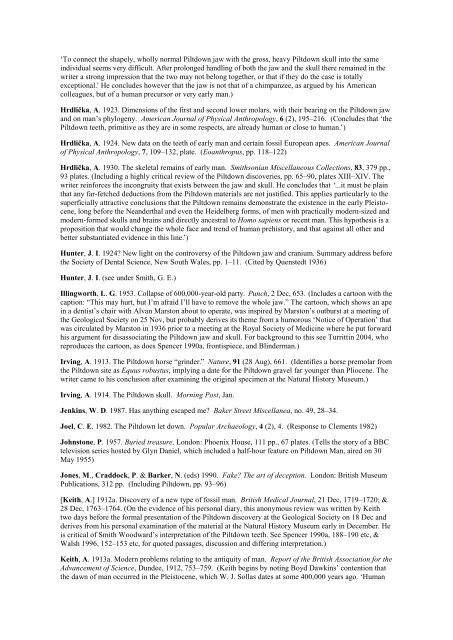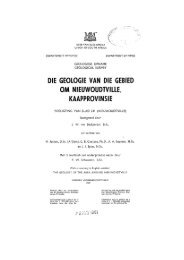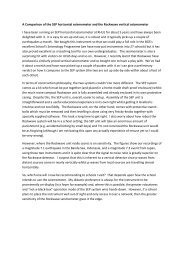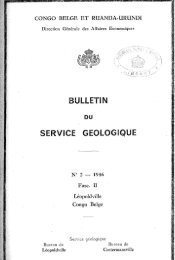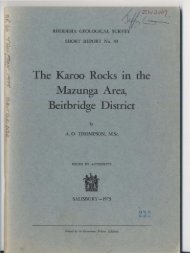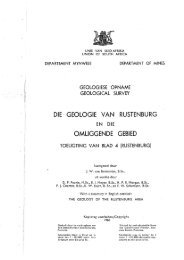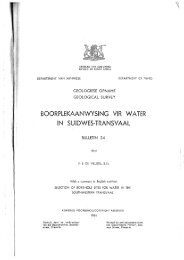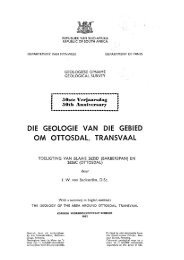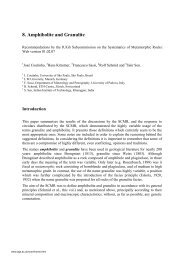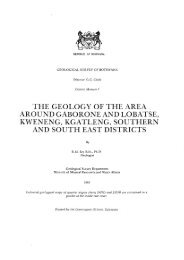Bibliography - British Geological Survey
Bibliography - British Geological Survey
Bibliography - British Geological Survey
Create successful ePaper yourself
Turn your PDF publications into a flip-book with our unique Google optimized e-Paper software.
‘To connect the shapely, wholly normal Piltdown jaw with the gross, heavy Piltdown skull into the same<br />
individual seems very difficult. After prolonged handling of both the jaw and the skull there remained in the<br />
writer a strong impression that the two may not belong together, or that if they do the case is totally<br />
exceptional.’ He concludes however that the jaw is not that of a chimpanzee, as argued by his American<br />
colleagues, but of a human precursor or very early man.)<br />
Hrdlička, A. 1923. Dimensions of the first and second lower molars, with their bearing on the Piltdown jaw<br />
and on man’s phylogeny. American Journal of Physical Anthropology, 6 (2), 195–216. (Concludes that ‘the<br />
Piltdown teeth, primitive as they are in some respects, are already human or close to human.’)<br />
Hrdlička, A. 1924. New data on the teeth of early man and certain fossil European apes. American Journal<br />
of Physical Anthropology, 7, 109–132, plate. (Eoanthropus, pp. 118–122)<br />
Hrdlička, A. 1930. The skeletal remains of early man. Smithsonian Miscellaneous Collections, 83, 379 pp.,<br />
93 plates. (Including a highly critical review of the Piltdown discoveries, pp. 65–90, plates XIII–XIV. The<br />
writer reinforces the incongruity that exists between the jaw and skull. He concludes that ‘...it must be plain<br />
that any far-fetched deductions from the Piltdown materials are not justified. This applies particularly to the<br />
superficially attractive conclusions that the Piltdown remains demonstrate the existence in the early Pleistocene,<br />
long before the Neanderthal and even the Heidelberg forms, of men with practically modern-sized and<br />
modern-formed skulls and brains and directly ancestral to Homo sapiens or recent man. This hypothesis is a<br />
proposition that would change the whole face and trend of human prehistory, and that against all other and<br />
better substantiated evidence in this line.’)<br />
Hunter, J. I. 1924? New light on the controversy of the Piltdown jaw and cranium. Summary address before<br />
the Society of Dental Science, New South Wales, pp. 1–11. (Cited by Quenstedt 1936)<br />
Hunter, J. I. (see under Smith, G. E.)<br />
Illingworth, L. G. 1953. Collapse of 600,000-year-old party. Punch, 2 Dec, 653. (Includes a cartoon with the<br />
caption: “This may hurt, but I’m afraid I’ll have to remove the whole jaw.” The cartoon, which shows an ape<br />
in a dentist’s chair with Alvan Marston about to operate, was inspired by Marston’s outburst at a meeting of<br />
the <strong>Geological</strong> Society on 25 Nov, but probably derives its theme from a humorous ‘Notice of Operation’ that<br />
was circulated by Marston in 1936 prior to a meeting at the Royal Society of Medicine where he put forward<br />
his argument for disassociating the Piltdown jaw and skull. For background to this see Turrittin 2004, who<br />
reproduces the cartoon, as does Spencer 1990a, frontispiece, and Blinderman.)<br />
Irving, A. 1913. The Piltdown horse “grinder.” Nature, 91 (28 Aug), 661. (Identifies a horse premolar from<br />
the Piltdown site as Equus robustus, implying a date for the Piltdown gravel far younger than Pliocene. The<br />
writer came to his conclusion after examining the original specimen at the Natural History Museum.)<br />
Irving, A. 1914. The Piltdown skull. Morning Post, Jan.<br />
Jenkins, W. D. 1987. Has anything escaped me? Baker Street Miscellanea, no. 49, 28‒34.<br />
Joel, C. E. 1982. The Piltdown let down. Popular Archaeology, 4 (2), 4. (Response to Clements 1982)<br />
Johnstone, P. 1957. Buried treasure. London: Phoenix House, 111 pp., 67 plates. (Tells the story of a BBC<br />
television series hosted by Glyn Daniel, which included a half-hour feature on Piltdown Man, aired on 30<br />
May 1955)<br />
Jones, M., Craddock, P. & Barker, N. (eds) 1990. Fake? The art of deception. London: <strong>British</strong> Museum<br />
Publications, 312 pp. (Including Piltdown, pp. 93–96)<br />
[Keith, A.] 1912a. Discovery of a new type of fossil man. <strong>British</strong> Medical Journal, 21 Dec, 1719–1720; &<br />
28 Dec, 1763–1764. (On the evidence of his personal diary, this anonymous review was written by Keith<br />
two days before the formal presentation of the Piltdown discovery at the <strong>Geological</strong> Society on 18 Dec and<br />
derives from his personal examination of the material at the Natural History Museum early in December. He<br />
is critical of Smith Woodward’s interpretation of the Piltdown teeth. See Spencer 1990a, 188–190 etc, &<br />
Walsh 1996, 152–153 etc, for quoted passages, discussion and differing interpretation.)<br />
Keith, A. 1913a. Modern problems relating to the antiquity of man. Report of the <strong>British</strong> Association for the<br />
Advancement of Science, Dundee, 1912, 753‒759. (Keith begins by noting Boyd Dawkins’ contention that<br />
the dawn of man occurred in the Pleistocene, which W. J. Sollas dates at some 400,000 years ago. ‘Human


